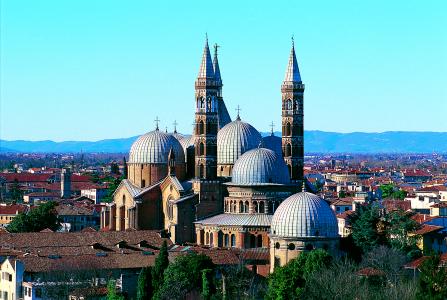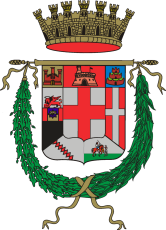
Tipologia museo

Descrizione
Basilica di Sant'Antonio è il centro religioso più importante della città e meta di migliaia di pellegrini che ogni anno e in particolare il 13 giugno, festa del Santo invadono la città per la famosa processione. La Basilica fu iniziata nel 1232 per custodire la tomba del frate francescano Antonio, morto a Padova nel 1231. La vasta costruzione presenta nella sua complessa struttura una caratteristica fusione di stili: elementi romanici nella facciata a campana, gotici nella pianta del deambulatorio con le sette cappelle bizantini nelle otto cupole rivestite in piombo e moreschi nei due campanili sottili e slanciati. Il tempio fu subito oggetto di attenzioni e cure anche da parte del Comune di Padova che chiamò i più valenti artisti per decorarlo, a partire da Giotto che pare lavorò per il Capitolo dei Frati nell'attuale omonimo chiostro.
Le tre porte in bronzo sono state realizzate dall'architetto Camillo Boito (1895). L'interno a croce latina e a tre navate che si uniscono in semicerchio dietro la tribuna dove si aprono nove cappelle radiali è un concentrato di capolavori. Attirano la nostra attenzione soprattutto i monumenti funebri di medici, guerrieri, prelati e letterati.
A Michele Sanmicheli si devono il Monumento al cardinale Pietro Bembo e quello in onore del nobile veneziano Alessandro Contarini. La prima cappella in cui riposa il Gattamelata fu edificata in stile gotico nel 1458 su richiesta della moglie per accogliere la tomba del marito condottiero. Superata la Cappella del Crocifisso o del Sacrocuore incontriamo la Cappella di S. Giacomo, o di S. Felice, che rappresenta uno straordinario esempio di arte gotica veneziana. Sopra la cappella torreggia l'organo tardo ottocentesco che conta ben 4189 canne. Al di là della sagrestia con armadio quattrocentesco la trecentesca Sala del Capitolo ospita un frammento di Crocifissione attribuita a Giotto e brani di affreschi della sua bottega. L'altare maggiore è preceduto da una balaustra in marmo rosso (1661) con le statue della Fede, Carità, Temperanza e Speranza di Tiziano Aspetti (1593). Nelle pareti si possono ammirare dodici bassorilievi in bronzo che rappresentano scene dell'Antico Testamento di Andrea Briosco e Bartolomeo Beliamo.
L'altare maggiore è uno dei monumenti più prestigiosi della Basilica. Fu ideato ed eseguito tra il 1443 e il 1450 da Donatello, che fu anche autore delle sculture in bronzo dorato che adornano l'altare stesso. Un grande Crocifisso sovrasta la Madonna col Bimbo seduta in trono circondata dalle statue dei Santi protettori di Padova. Di Donatello è anche, dietro l'altare, la Deposizione in pietra, mentre il monumentale candelabro (1507-1515) con figurazioni sacre e allegoriche situato sulla sinistra fu realizzato da Andrea Briosco.
Il deambulatorio si apre sulla serie di cappelle. La maggiore, che ospita il Tesoro, fu costruita in stile barocco. Qui sono custodite le numerose reliquie; tra le più venerate ci sono la lingua e il mento del santo. Di immenso valore artistico sono anche i chiostri del convento: il Chiostro del Noviziato, il Chiostro del Capitolo o della Magnolia, il Chiostro del Generale e il Chiostro del Museo Antoniano.
Al piano superiore del Chiostro del Generale si trova la Biblioteca Antoniana. Fu istituita nel XIII secolo e al giorno d’oggi contiene oltre 85.000 volumi, tra cui numerosi manoscritti antichi, alcuni risalenti al IX-X secolo.
 St. Antonio’s Cathedral
St. Antonio’s Cathedral
St. Antonio’s Cathedral is the city’s most important religious center. It is the destination of millions of tourists every year, and, in particular, on the 13th of June, the Saint’s feast day, when they swarm the city to participate in the famous procession. The cathedral was started in 1232 to shield the tomb of the Franciscan friar Antonio, who died in Padua in 1231. The grand building presents a peculiar fusion of different styles: Romanesque elements on the gabled facade and Gothic features on the plant of the deambulatory with the seven Byzantine chapels in the eight domes covered with lead and Moorish in the two thin, slender bell towers. The temple was immediately given attention and care by the city of Padua, which called the most talented artists to decorate the church, starting with Giotto, that worked for the Chapters of the Friars in the current cloister of the same name. The architect Camillo Boito realized the three bronze doors (1895).
The interior is an ensemble of chef d’oeuvre: a Latin cross with three naves joined up into a half circle behind the grandstand surrounded by nine radial chapels. The memorials of physicians, warriors, prelates, and intellectuals mainly catch our attention. Michele Sanmicheli made possible the realization of the Monuments of Pietro Bembo and the Venetian aristocrat Alessandro Contarini. The first chapel, in which the Gattamelata rests, was built in Gothic style in 1458 at his wife’s request to hold the tomb of the husband and leader. Beyond the Crucifix Chapel or Sacrocuore Chapel, there is St. Giacomo, or St. Felice, Chapel, an extraordinary example of Venetian Gothic art. Above the chapel towers the late 19th-century organ that counts no less than 4189 pipes. After the sacristy containing a fifteen-century cabinet, the fourteenth-century Hall of Chapter hosts a fragment of the Crucifixion attributed to Giotto and scraps of frescos from his atelier. A balustrade in red marble (1661) incorporating the statues of Faith, Charity, Temperance, and Hope and realized by Tiziano Aspetti (1593) precedes the High Altar. Twelve bas-reliefs in bronze, artworks by Andrea Briosco and Bartolomeo Beliamo representing scenes from the Ancient Testament, decorate the walls. The High Altar is one of the most prestigious monuments of the cathedral. It was designed and created between 1443 and 1450 by Donatello, who was as well the author of the gilded bronze sculptures that adorn it. Above the Madonna and Child, sitting on the throne and surrounded by the statues of the Patron Saints of Padua, stands a large crucifix. Donatello also realized the Deposition behind the Altar. Instead, the majestic candelabra with sacred and symbolic representations is a piece of art created by Andrea Briosco (1507-1515). The deambulatory overlooks the nine chapels; the Major Chapel, built in baroque style, holds the so-called Treasure. This Treasure is an ensemble of relics, among which the Saint’s tongue and chin are the most revered. The cloisters in the convent are astonishing: the Cloister of the Novice, the Cloister of the Chapter or the Magnolia, the Cloister of the General, and the Cloister of the Antonian Museum. The Antonian library is on the upper floor of the Cloister of the General. It was founded in the XIII century and now contains over 85.000 volumes, including many manuscripts, some of which date back to the IX-X centuries.

